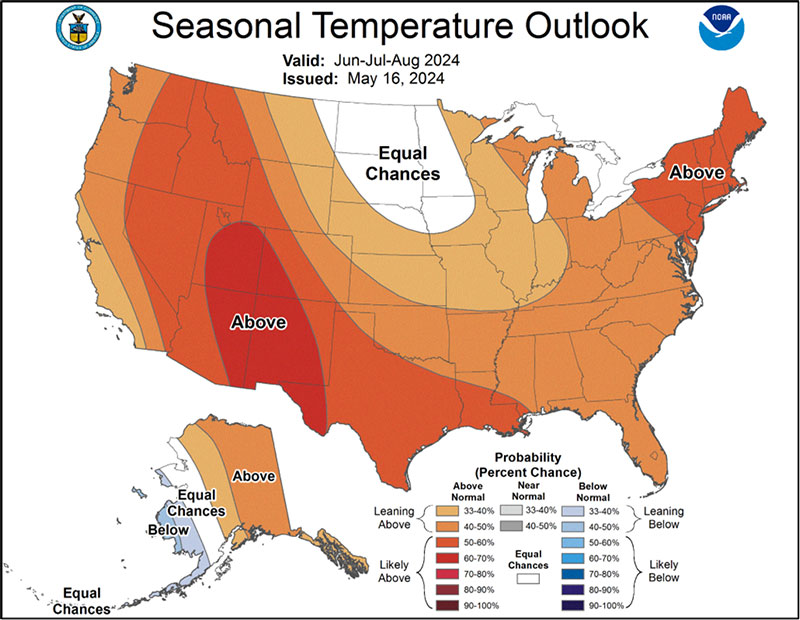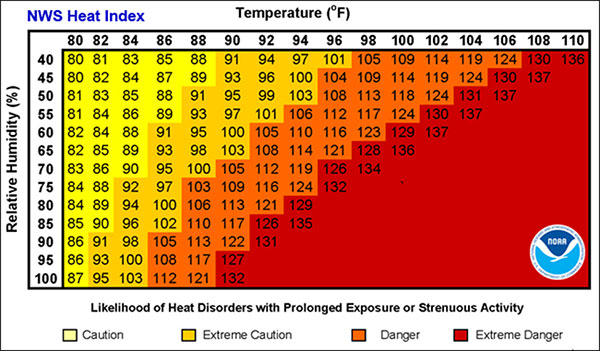Rising Heat: Insights for Summer 2024
Published: June 19th, 2024
Aside from delightful frozen treats and poolside afternoons, how do you imagine the summer season? For many people, the unforgettable sensation of excessive heat swiftly comes to mind. Each year summertime around the world involves dangerous extreme heat, and the United States is no exception. Although astronomical summer in the Northern Hemisphere doesn’t start until the 20th of June, meteorological summer, which officially began on June 1st, has already kicked off with above-average heat across much of the country. The National Weather Service (NWS) issues heat alerts— including excessive heat advisories, watches, and warnings —when hot surface temperature and high relative humidity work together to form conditions where heat-related illnesses can occur (1). Without access to shade, hydration, and air-conditioned spaces, the summer season can prove to be deadly for anyone caught in its burning grip for too long.
Summer 2024 Temperature Outlook
While July is the hottest month on average for the contiguous U.S., uncomfortably warm conditions can occur sooner than you may expect. This year the San Francisco Bay Area, which is often noted for its temperate climate, recorded a new daily high temperature for May 10th, at 84°F (2). By the start of June, much of California, southern Nevada, Arizona, and central to southern Texas were preparing for an imminent heat wave. Thanks to an upper-level ridge pushing in from the west, the first significant heat event of the season cleared away cooling cloud cover and triggered the issuance of heat alerts to more than 36 million people (3). Temperatures in the range of 90s-100s Fahrenheit were forecast across Central California to the Great Basin and into Texas, while temperatures exceeding 110°F were expected in desert regions of the Southwest, including major cities like Las Vegas. Between June 5th and 6th, the NWS Las Vegas forecast area saw numerous temperature records broken: a new daily high of 111°F was recorded in the city, and likewise for Death Valley, which reached a high of 122°F (4). With July still ahead of us, what sort of conditions should we expect during the height of summer?
The NWS Climate Prediction Center (CPC) provides 3-month climatological outlooks for temperature and precipitation. The current temperature outlook for June through August estimates that nearly the entire contiguous U.S. has at least a 33% chance of experiencing summer temperatures above climatological average, except for the upper Midwest, which has equal chances of either normal or above normal temperatures this season (figure 1).

The CPC’s seasonal outlook suggests that most of the U.S. will experience a hotter-than-average summer this year, which could lead to widespread dangerous heat impacts across vast swaths of the country. Hot temperatures alone are hazardous, but coupled with a humid atmosphere, the situation can become suffocating. When both temperature and humidity are high, the conditions for heat stress increase because saturated air makes it difficult for our sweat to evaporate and cool our body temperature. Consider the heat index, or apparent temperature, in addition to air temperature to better understand how humidity and temperature influence the way heat affects the human body (5): The NWS created a chart that provides the heat index for given temperature and relative humidity values which anyone can use to evaluate their heat risk prior to outdoor engagements.

The Importance of Managing Extreme Heat
The human body responds to excessive heat through a range of unpleasant and sometimes life-threatening illnesses. This includes heat exhaustion, heat stroke, dehydration, fainting, muscle cramps, and more (6). Without intervention, these effects can lead to hospitalization and even death. The U.S. sees around 700 heat-related deaths in an average year, but an increasing trend has been observed since 2021. In 2023 alone, approximately 2,302 heat-related deaths occurred (7). Not only is heat the leading cause of weather-associated fatalities in the U.S., but it claims twice as many lives on average than the second leading cause of weather-associated fatalities, floods (7). While roaring floods are not to be reckoned with, extreme heat can silently impact tens of millions of people over extended periods of time. The first step to managing extreme heat is knowing your risk— seniors, infants and young children, overweight individuals, people who overexert when working or exercising outdoors, and those with certain medical conditions are among the greatest risk for heat-related illnesses (7).
It can be difficult to manage the symptoms of heat stress, especially during a heat wave. When high temperatures and humidity persist for an extended time, overnight lows might not settle below 75-80°F. This prolonged exposure to heat can exacerbate heat-related illnesses, and without air conditioning, we struggle to find an opportunity to cool down. This is when heat stress can compound day after day, and why it’s crucial to pay attention to how your body responds to heat stress as well as the advice of your local public health officials and meteorologists during episodes of extreme heat. In the past few decades, air-conditioned homes have grown in demand for those in higher latitudes: global atmospheric temperatures continue to rise, which means these heat waves will likely become more frequent where they are otherwise unexpected. The prevalence of heat waves in regions unaccustomed to extreme heat will disproportionately affect populations without the means to install and/or run an air-conditioner, including those who are already vulnerable to heat-related illnesses.
Final Thoughts
It feels natural to prefer the summer season for its long, sunny days and countless opportunities to enjoy the outdoors. But as we navigate through increasingly sweltering summers, it’s imperative to recognize and mitigate the impacts of extreme heat. The CPC’s outlook for this summer stresses the urgent need for comprehensive heat management strategies to not only help people endure the discomfort but protect the most vulnerable populations from heat stress. Along with other useful heat products like the heat index chart, the NWS provides an experimental, interactive heat-risk forecast map to identify potential heat risks in a seven-day period. This tool provides guidance for heat-sensitive populations and decision-makers alike who “need to take actions [against the heat] at levels that may be below current NWS heat product levels” (8). When used alongside your official local forecast, the HeatRisk product can help you understand your risk for heat stress that week. As you continue to enjoy the summer, remember to keep cool— and stay hydrated!
References
- “Excessive Heat” NOAA NWS Heat Products
- “San Francisco Bay Area – Record Report” NOAA NWS
- “Heat” NIHHIS
- “X” – NWS Las Vegas
- “What is the heat index?” NOAA NWS
- “Weather Related Fatality and Injury Statistics” NOAA NWS
- “Preventing Heat-Related Illnesses” CDC Extreme Heat
- “NWS HeatRisk” Experimental, NOAA NWS

